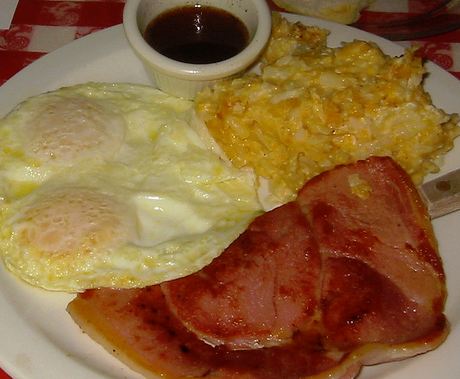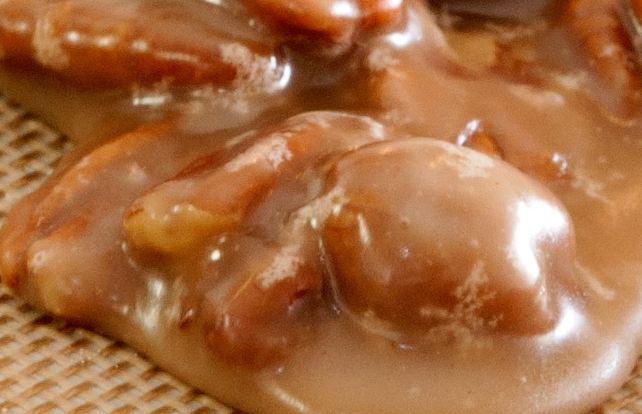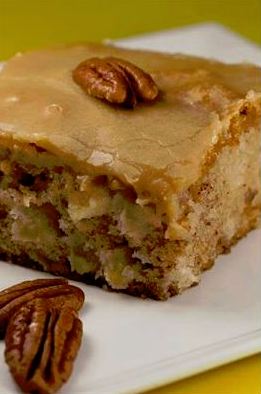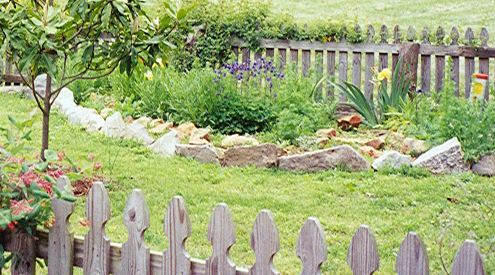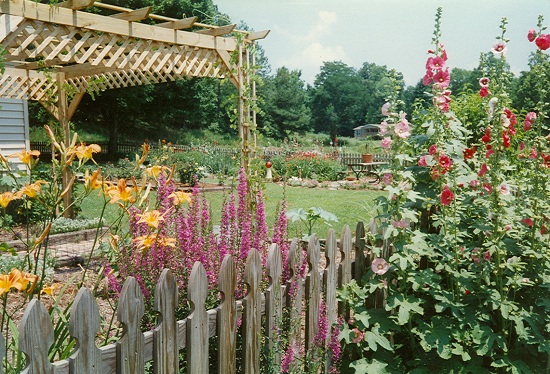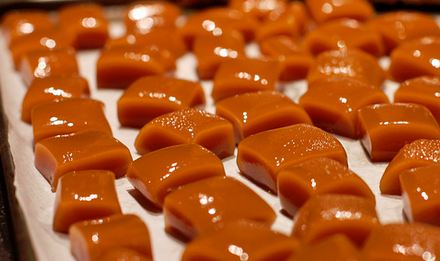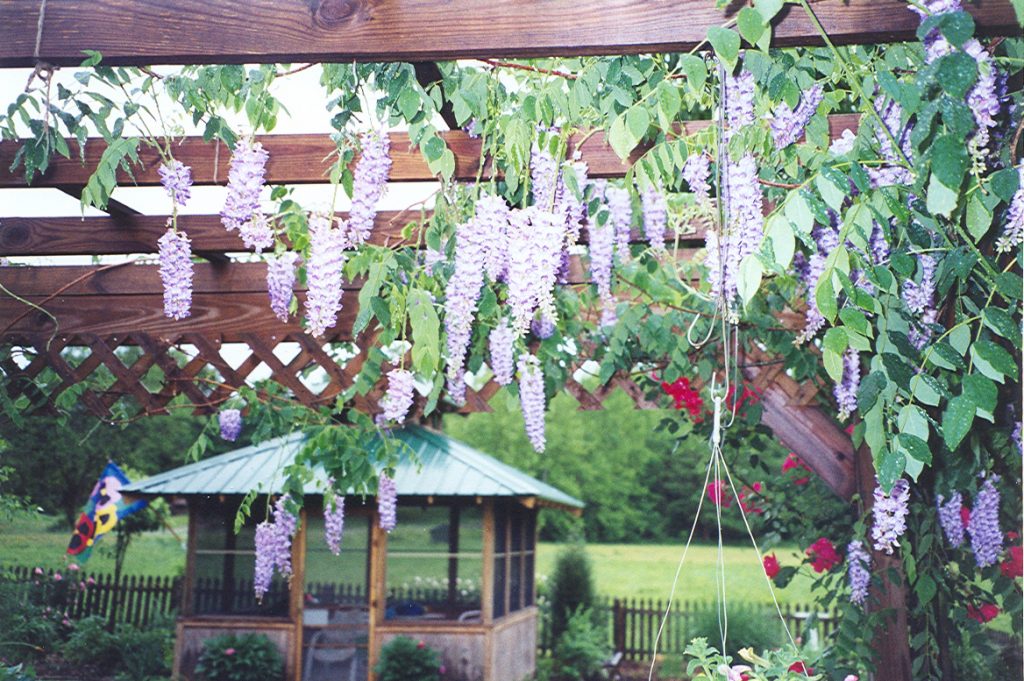There’s nothing better on a cold Kentucky morning than this traditional breakfast of country ham and red eye gravy. If you’ve got an active morning raking leaves ahead of you, try this breakfast on for extra taste and stamina. Continue reading “Kentucky Country Ham and Red Eye Gravy”
Night of the Escaped Convict
Grandma and Grandpa always went to bed with the chickens. Their little house didn’t have electricity, so on hot summer evenings they lay on top of the covers in their respective beds, hoping a stray breeze would meander in from the screen door at their feet.
On one such evening many years ago they were lying there just after sunset when a warning came across the old Bakelite radio: “At 5:45 this evening a dangerous convict escaped from Kentucky State Penitentiary. Citizens are advised to say indoors. This escapee should be considered armed and dangerous. If you have any knowledge as to his whereabouts, please call your local police.” Continue reading “Night of the Escaped Convict”
Perfect Pralines
Every fall my sweet tooth begins to throb for something homemade. And easy-to-make pralines are high on the list.
Pralines (pronounced “prah-leens”) are among the simplest and most delicious of all Southern confections. Like most anything, pralines are best when made fresh at home–much better than those you see wrapped in plastic near a store’s cash register. This recipe has never failed me. Try them! Continue reading “Perfect Pralines”
Country-Fried Steak ‘n Gravy
Ingredients-steak
- 2 pounds cubed steak
- 1 1/2 cups all-purpose flour
- 1/2 cup dried onion flakes
- 1/2 teaspoon black pepper
- 1 1/2 teaspoons salt
- 3/4 cup of vegetable oil Continue reading “Country-Fried Steak ‘n Gravy”
Old-Fashioned Fresh Apple Cake
When I lived in Virginia this was a favorite. You would often see it at bake sales and fairs. I wanted this recipe for years and finally got it. (Courtesy of my friend, Ina).
It’s absolutely yummy. Continue reading “Old-Fashioned Fresh Apple Cake”
The Teufel
Steven knew he should not be out at night alone. He had been told repeatedly to stay inside with the doors locked after dark. But when the moonlight beckoned outside his bedroom window, it was more than he could resist.
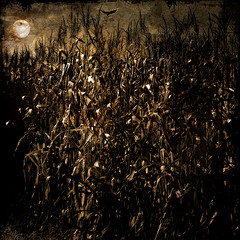
He made his way down the hill behind the house and into the corn field. The moon went behind a cloud and the long rows of corn were darkened. The nights were beginning to cool; a small breeze moved the leaves of the drying corn. He stopped to listen to the rustling of leaves–to inhale the dry, dusty stalks. Despite the night’s chill the dirt was warm under his bare feet. He pulled the drying silk from an ear of corn.
Suddenly there was a larger rustling of corn a few feet from Steven. Something big was moving through the field. It couldn’t be a person–people tended to stay in rows. This thing was bending the tassels of corn as it moved cross-ways through the patch. Steven became alarmed. It wasn’t more than thirty feet away now.
“Who’s there?” he said.
No answer, but the thing stopped.
Who’s there, I said!” Continue reading “The Teufel”
Five Favorite Laid-back Paducah Restaurants
Paducah has its share of chain type restaurants, as well as fancier eating establishments. Many of them have good food and service. But it also has a number of laid-back, down-home eating places near and dear to my heart. Here are five: Continue reading “Five Favorite Laid-back Paducah Restaurants”
A Death at the Beach
I was ten years old the first time I saw a dead person up close. It wasn’t at a funeral, where most people see their first body, because I had not yet been to one. It wasn’t at the scene of a horrible highway accident, for I usually looked away when we came upon one. Car crashes happened with some frequency on the two-lane roads of the 60’s, and I do remember seeing a body lying half in and half out of a car once, but only from a distance. Mom managed to shield my eyes before we got close enough to see blood. No, when I first met death up close it was on a beach. Continue reading “A Death at the Beach”
Bringing Houseplants Back Indoors
It’s getting near the time when houseplants–like children being called in for supper–must return indoors for the winter season. They’ve hung out on a porch or patio, soaking up the sun and renewing themselves all summer. Now it’s nearing the time for a well-deserved rest.
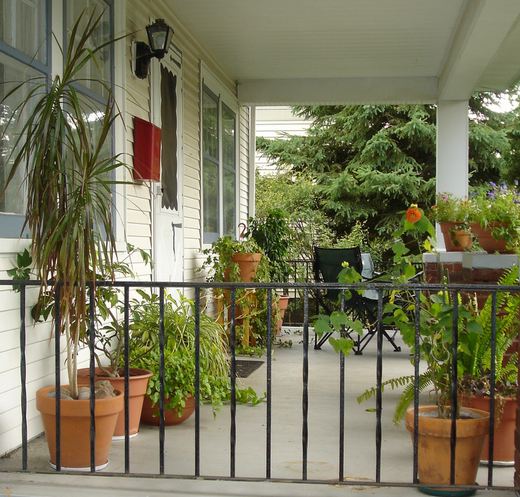
But there are a few things to keep in mind before bringing them back indoors. Continue reading “Bringing Houseplants Back Indoors”
Fall Gardening Advice
Grab your spades and shovels, gardeners.
Like it or not the fall planting season is upon us. A bit of preparation now will yield big results next year, so don’t be short-sighted and put off these recommended activities.

For fall color. Unfortunately, if you haven’t been nursing your annuals along they are likely past their glory. There are a few—notably chrysanthemums and pansies—that like cooler weather and reward the grower with abundant fall color. But the vast majority of summer annuals are pretty much played out by this time each year. (You may coax some additional blossoms from healthy plants by pruning them heavily now). Continue reading “Fall Gardening Advice”
Too Many Words?
Decades of Journals

I had a journalism teacher in high school named Jean Williams, who designated me an editor of our high school newspaper. We got along famously, and I continued to visit Ms.Williams for many years after graduation. On one of those visits she advised me to begin keeping a journal. She said, “It’s our nature that we forget some things, and remember others wrongly. You will thank me one day.” Unfortunately, she did not live long enough for me to thank her, but as I sit here–over three million words later–I am truly grateful that I took her advice.
I began my first journal 34 years ago, and have kept one each year since. I was living in Roanoke, Virginia in 1979, and bought my first blank journal at Roanoke Stationery downtown. It was one of those old shops with high stamped tin ceilings and creaking wooden floors. Dimly lit shelves were lined top to bottom with stationery, pens, tablets–all manner of writing implements. It smelled like the first day of school–like ink and fresh paper. Two old gentlemen approached–each with long white whiskers, looking like they stepped out of the 1800’s–and quietly asked if they could be of assistance. I told them I wanted a journal and they directed me immediately to a variety of them, some of which had the upcoming year embossed on their covers. Continue reading “Too Many Words?”
Made in the Shade
Ah, the shade garden. Cool, dark and serene.
On hot August days nothing beats retreating to the sheltering shade. Whether it’s an old lawn chair under a tree, or a hammock swinging gently under dappled sunlight, escaping the heat and activity of a summer’s day could be just a few feet away.
If you don’t have a large shade tree where you live, you can create your own artificial shade. Here is a photo of a shady area under a pergola I built. It didn’t take long for the wisteria and hummingbird vine to create quite a shady respite.
I let my green thumb sort of go wild, I’m afraid. I may have over-planted a bit, but I just let everything go wild to provide even more shade from the hot afternoon sun. (see below)
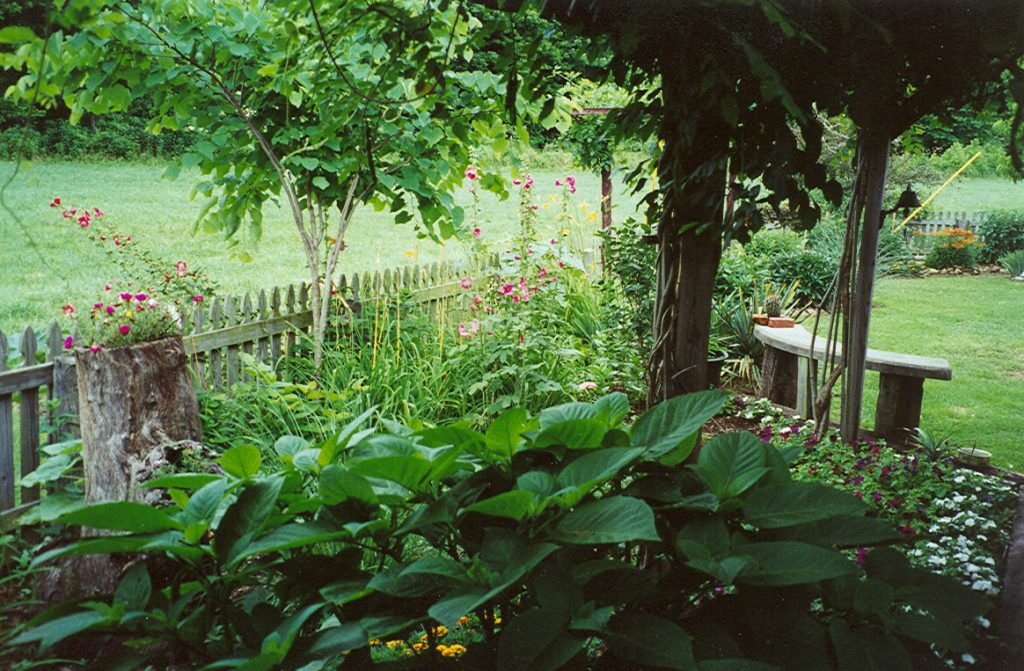
A variety of plants love the shade and are thankfully quite easy to grow. For color nothing beats impatiens, and for cool contrast to dark leaves, try caladiums in shades of white or pale green, in addition to the usual red varieties. Don’t forget hostas for perennial ground cover. And elephant ears make a delightfully bold statement. Ferns (the native kind–not the annual Boston ferns) can be easily planted and will return and spread each year. Even moss can be made to flourish around stone if conditions are wet enough.
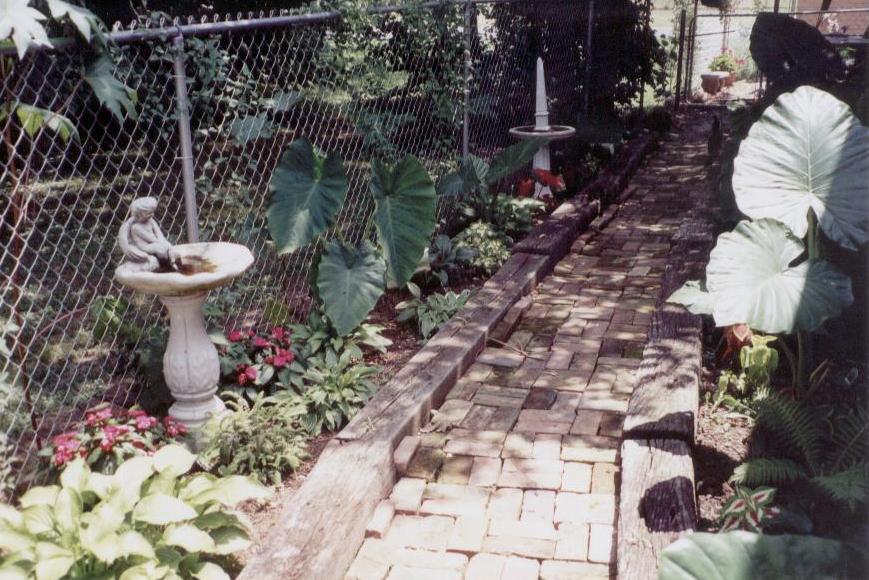
Just keep the water hose handy, for most shade plants also require evenly moist soil conditions.
© Wade Kingston
Under the Haystack, Fast Asleep
Goosebumps and tingles. Goosebumps ran up both my arms and tingled around my neck as I tried to see out the bedroom window. At first, all I could make out in the dark were raindrops trickling down the panes of glass. It was summer, and the window was cracked open about an inch at the bottom. I could hear the wind moving the limbs of the big elm a few feet away. During a lightning flash I saw the top of the tree swaying to and fro.

Beside me in the feather bed, Grandma was beginning to snore. She had just finished scaring me half witless with the story of the three “Billy Goats Gruff.” I didn’t know exactly what a troll looked like, but I was fairly certain it would eat a skinny little redheaded boy alive. And so I lay awake, listening to the rain and imagining things out there in the rainy dark. Things that hid behind elm trees and grunted into the wind. Things just outside the window, with only glass between us. Continue reading “Under the Haystack, Fast Asleep”
Define Your Garden Space
Gardens, particularly an English “cottage garden” can get quite unruly unless the space has a definite border of brick or timber. I have used cross ties, landscaping timbers, limestone rock and old brick to contain and frame a garden. Fallen logs are a favorite as well.
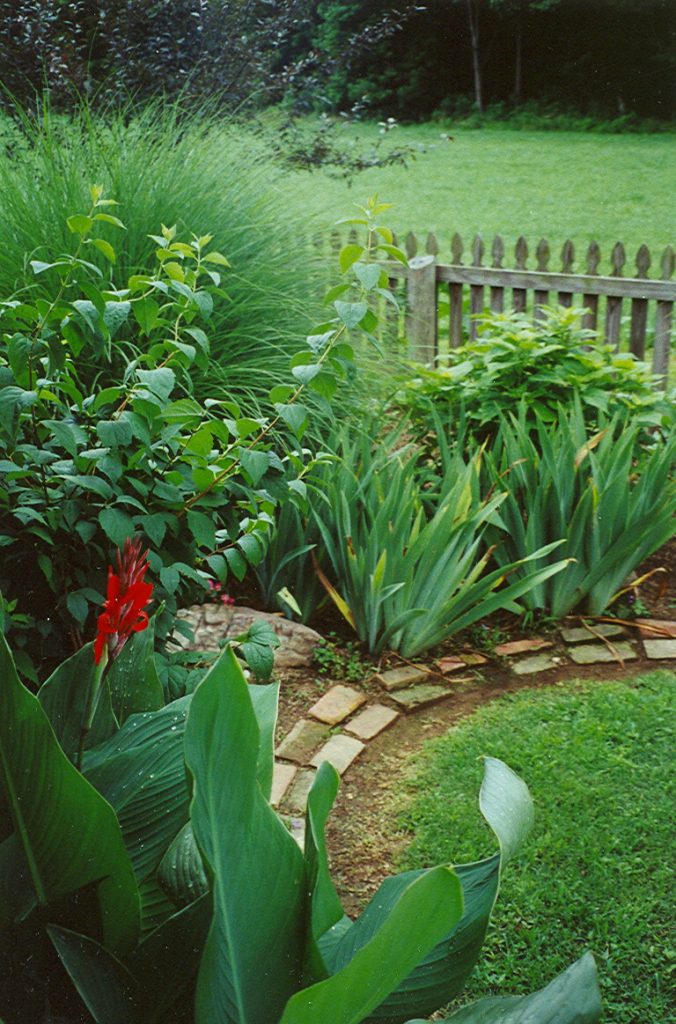
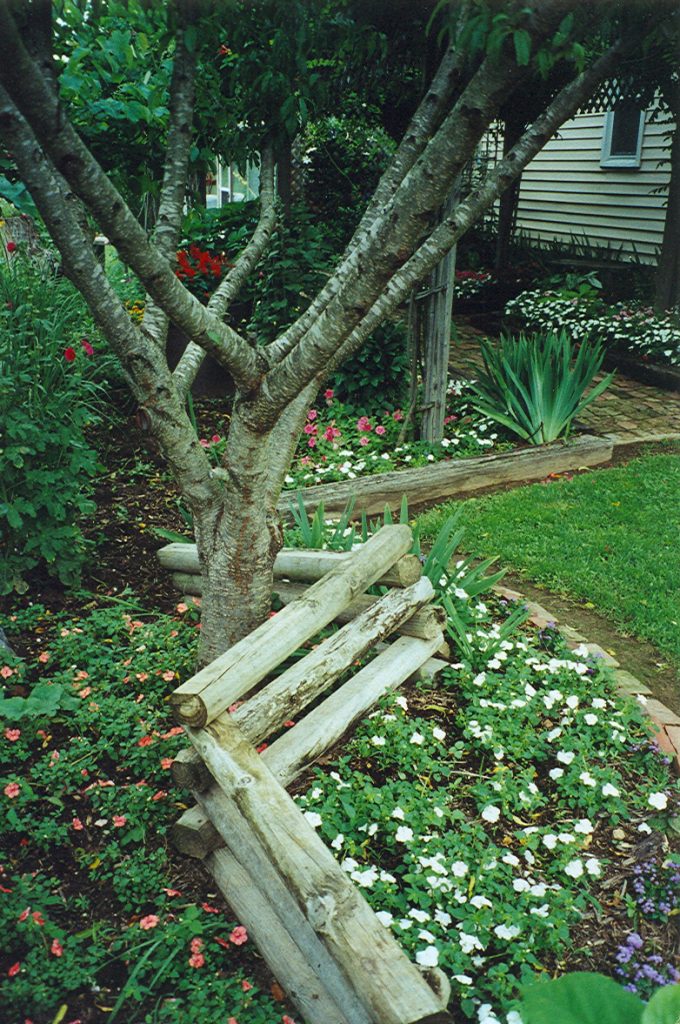
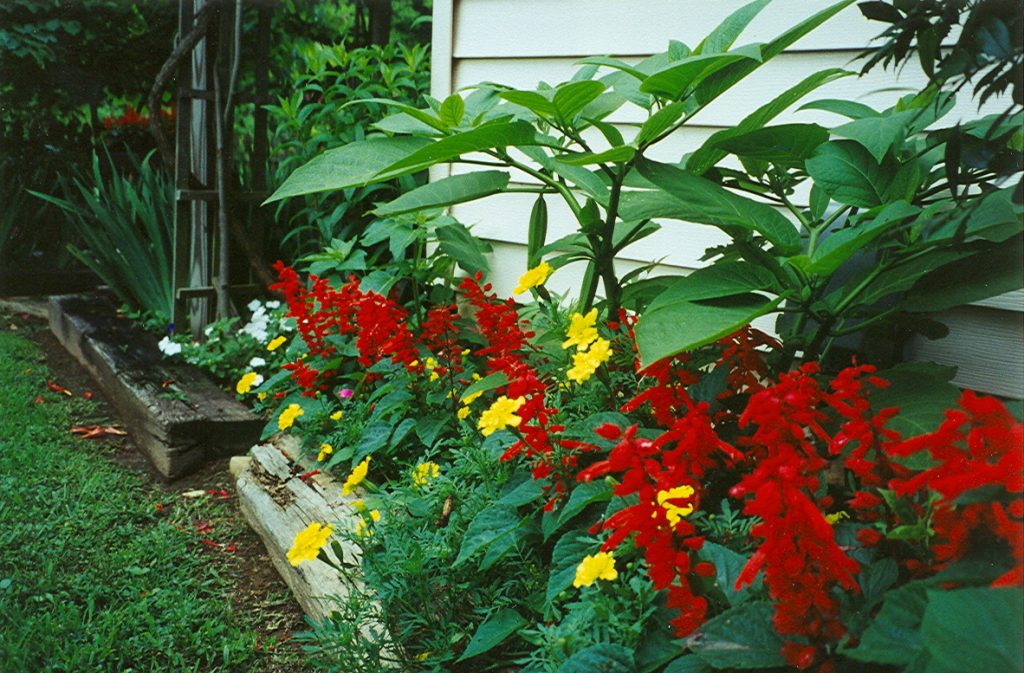
And though I have used old railroad ties in the past, it is worth noting that “new” railroad timbers are infused with creosote, which can be toxic to both plants and people (if used indoors, like a greenhouse). If you can attain very old timbers, they have a weathered look and most of the creosote would have long leached out of them. If you want to be extra cautious, line your plant beds so that the timbers don’t come in direct contact with the soil.
Limestone rock contains this corner of the yardIf you have access to woodland areas, which are common in our part of the country, you may find an old fallen log that would fit your bill. Cedar works especially well since it takes many years for it to decompose. Be kind to your woodland plants and animals and don’t deplete your wooded area of all fallen trees. Plants, animals, and even insects depend on those logs. And really there is nothing quite more beautiful than an old rotted log with ferns and lichens growing all over it.
What do you use to shore up a border? Please return to My Garden Buddy and enter the conversation. Thanks.
© Wade Kingston
Best Blue Cheese Dressing I’ve Eaten
Let’s face it: You either like blue cheese or you don’t. If you like it you know there’s no other flavor quite like it. Just a whiff of it sets my mouth to drooling. And those who don’t like it–and there are many–really don’t like it, and are prone to wrinkling their nose in disgust. (My own father makes gagging noises).
Be that as it may, it seldom deters those of us who love it from ordering it. It’s just too tempting. A few years back I had the opportunity to save the following recipe from a five star hotel. It always gets raves from the ” blue lovers” whenever I make it.
When My Boss Was Murdered
Sometimes the unthinkable becomes reality and murder touches our lives. It can hit us so unexpectedly that it’s like a sucker punch knocking us breathless. Such was the case with me in Roanoke, Virginia, in the wee cold hours of January 3, 1986.
When the phone rang at 4 a.m. that Friday morning I fumbled for it, still half asleep. For a second I didn’t recognize the sobbing sounds coming from my boss’ secretary, Carolyn, on the other end of the line. I had never heard her cry. She had always been such a cheerful person. Then she stopped sobbing long enough to speak. “Wade, Tony is dead.” Continue reading “When My Boss Was Murdered”
Baked Pork Chops with Mushroom Gravy
Here’s an easy recipe I use for making tender pork chops with a savory mushroom gravy. There’s usually plenty of gravy left over to go with mashed potatoes, which is pretty much a requirement in our family. Try it, you’ll like it.

For EASY Instructions click “Read More” below. Continue reading “Baked Pork Chops with Mushroom Gravy”
The High Hollyhocks of My Old Kentucky Home
For as far back as I can remember I have associated stately hollyhocks with my childhood homes in Kentucky. I spent a lot of time with my grandmother, and hollyhocks were her lifelong favorite. Recently a cousin sent me an old black and white photo of grandma–circa 1940’s–and in the background of the photo were hollyhocks, standing regally against the weathered clapboard of her house.

Grandma grew hundreds of hollyhocks on the rocky hillside of “Pea Ridge.” A forest of them towered over me as a child. I marked their progression upwards with each weekly visit.
And though hollyhocks generally love full sun, grandma’s hollyhocks grew to gigantic proportions–or so it seemed to a small boy–in the partial shade of a giant elm. The secret was her soil—dark earth amended through the years by countless buckets of chicken manure. It also helped that the hollyhocks were “out back” of the kitchen door, where grandma tossed a dishpan of water after each use.
About the only thing that grandma loved more than her flowers were her hens. The chickens loved nothing more than to dig around the hollyhocks for grubs. When the soil was dusty hens would flop around under the leaves, making low croaking sounds. In a way, the hollyhocks fed the chickens and the chickens fed the hollyhocks.
Hollyhocks against my fenceGrandma has been gone for 30 years, but I cannot pass a clump of lofty hollyhocks without thinking of her, which happens often around here. Hollyhocks along a fence or up against a barn wall are almost a given in the Kentucky countryside. And though many gardeners no longer grow hollyhocks, considering them old-fashioned or not stylish, I smile inside whenever I see them.
Do you associate a particular flower or shrub with a loved one? Please return to My Garden Buddy and enter the conversation. Thanks.
© Wade Kingston
Fantastic Home Made Caramels
So creamy and delicious you many never buy them in packages again.
I first made these between Thanksgiving and Christmas last year. Friends and family kept asking me when I was going to make more. Then of course I got the obligatory request for the recipe. This is the recipe I used, and having made several batches I can report it never failed. You can whip up a batch fairly quickly. For best results use a candy thermometer whenever making candy. It’s a very worthwhile investment. Continue reading “Fantastic Home Made Caramels”
Clinging and Draping Beauties
Nothing looks better on a fence, or a pergola, than a full blossoming vine. In this case I’m speaking of perennial vines, not the annuals like morning glory or moon flowers. Here in west Kentucky I have used a number of vigorous perennial vines that grow quite profusely in our climate. I began with a freebie–the wild wisteria.

Wisteria often gets a bad rap because it can be invasive. It’s true that one must keep wisteria “tamed” with pruning, otherwise it can get away from you. But the reward is a lovely cascade of pendulous violet blossoms each spring, which often arrive just as the butterflies and hummingbirds do. The sweet scent of wisteria is particularly delightful when planted overhead, say on a pergola or archway. I have also grown Japanese versions of wisteria in white as well as a deep purple.

When a fuller effect is needed, say on a large pergola, a mix of wisteria and hummingbird vine (trumpet vine) work well together. Both can be found for free just about anywhere in the country, and the hummingbird vine begins to bloom right after the wisteria finishes up. Again, pruning will be needed, and be sure to keep plantings away from electrical wires and poles. Not only is a pleasing shape attained from pruning, but the wisteria will actually have more and fuller blossoms when branches are pruned back.
Wisteria hanging from my pergolaAnother vine that can be quite lovely, and which blooms throughout the summer, is the Japanese variety of red honeysuckle. Very much like the wild varieties, these vines grow thickly and blossom profusely. They grow in almost any soil, prefer sunshine, and are practically maintenance free. Just prune them back if you feel they are getting larger than you want. Hummingbirds love them.
Another favorite climbing vine is the “Montana Rubens” variety of clematis. It grows quite thickly and the tiny white blooms arrive by the thousands long after other clematis have stopped blooming. It hits its peak in August and September in our area. The flowers have a nice scent, but the plant does have a tendency to attract Japanese beetles.
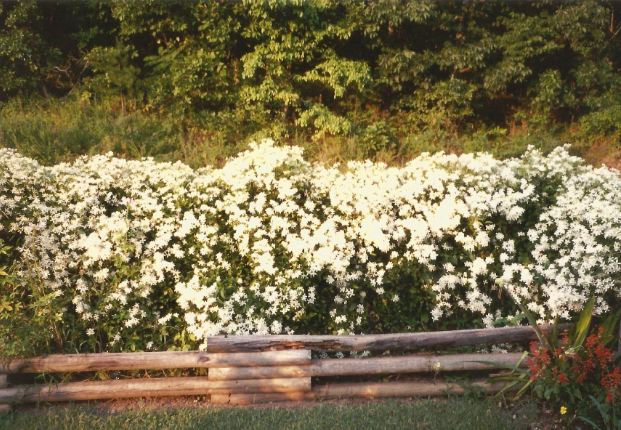
And last, but certainly not least, is perhaps my favorite blooming vine—clematis. Perhaps it’s because they grow so well in our alkaline soil, but clematis in shades of purple through pure white adorn fences, posts, and mailboxes throughout our area. My own secret with clematis is to mix limestone gravel in with the soil they are planted in. They love it.
What are your favorite “clinging vines”?
© Wade Kingston

